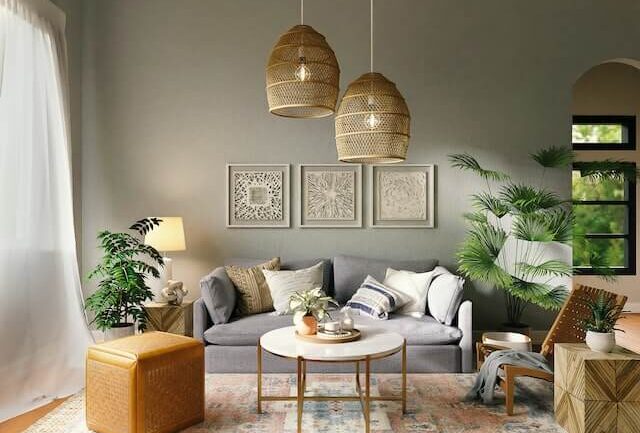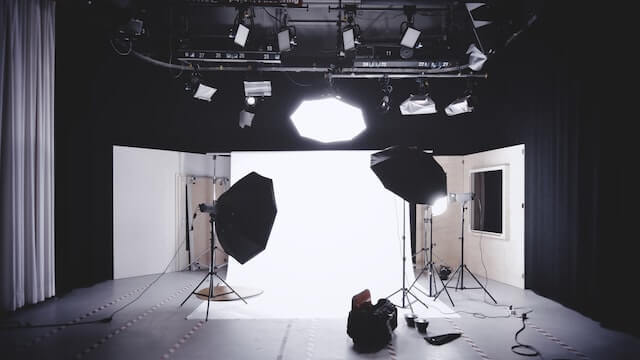Difficult lighting is one of the biggest challenges for real estate photographers. Whether you’re shooting a property exterior or interior, it’s not easy to determine what lighting will do the trick or what exposure settings will capture the property at its best.
Very often, the ambient light will not be at all flattering or the image will have more contrast than even high-end digital cameras can capture in a single exposure. Either way, real estate photographers need to be able to overcome such hurdles.
That’s where flash for real estate photography and HDR come in, but which one is best? Let’s see what options have to offer so you can make an informed decision and elevate your craft.
Flash for Real Estate Photography
When ambient light needs a bit of a boost, adding your own light using flash for real estate photography is an easy solution. Here are the advantages and disadvantages of using this resource:
Advantages of Flash for Real Estate Photography
 The biggest advantage that flash has to offer is that it will allow real estate photographers to change the light in the room however they see fit. For example, you can use it to accentuate areas you want to bring attention to.
The biggest advantage that flash has to offer is that it will allow real estate photographers to change the light in the room however they see fit. For example, you can use it to accentuate areas you want to bring attention to.
Photographers can add enough flash to your interior or exterior scenes to capture everything in a single exposure. Though it can be a bit complex to accomplish, it can be done.
Additionally, flash for real estate photography offers options. It gives you the freedom to illuminate the best areas and make up for natural lighting. However, not everything is perfect and there are a few drawbacks you need to be aware of when using this resource.
Disadvantages of Flash for Real Estate Photography
One of the main disadvantages is that the equipment can be expensive, especially if you’ll be needing more than one flash for real estate photography. The cost of lights, modifiers, brackets, stands, strobes, etc., racks up, so that’s something to keep in mind.
Additionally, setting up your flash can be quite time-consuming, which can be a problem when you have to produce a big volume of photographs. Using flash can make a shooting take two to three times longer. That’s because setup requires you to find the right settings for the scene.
How to Dominate Flash for Real Estate Photography
The first thing you need to do is frame the shot and identify the areas that you want to accentuate. Beds, couches, chairs, and tables often benefit from flash because they’re the main objects in the room.
Then, you need to determine what angles of the object you want to illuminate. The goal is to create a well-balanced scene, so you should consider illuminating from a similar direction as the ambient light is coming from.
What is a basic flash angles in real estate photography?
When we talk about basic angles, we are referring to flash angles you use to create a standard image of the property. The angle you choose depends on various factors. It is important to master these angles so that you can create images that appeal to your customers. You will find the following angles helpful in real estate photography:
1. Bouncing of white ceiling – Top down
This angle is helpful when you want to capture the entire room. For this, you have to stand in one corner of the room and then shoot. It is the most common angle that you would see when you visit an open house.
The best thing to do is bouncing light from the ceiling. Bouncing light from the white ceiling is easy when you use a light modifier such as a parabolic umbrella. It is important to have the flash unit above the camera and the light modifier below the lens. You can also use a large white wall to bounce the light. This will help you get a more natural effect. Another option is using a diffused fabric or a light reflector. Keep in mind that you must position the light source above the camera. This will help you create a highlight on the ceiling. This lighting technique is perfect for shooting wide shots of rooms or spaces.
2. Flash angle to the sides
 Giving more lights for different parts in the room.
Giving more lights for different parts in the room.
This is another basic angle that is helpful for creating a wide shot. You can do this by positioning the light either to the right or left side. This is best for real estate agents who want to show the whole house in one photograph. Let’s say you are taking photos of a living room. You can position the light on the right side and then shoot the whole room. You can also position the light on the left side and shoot the entire room. If you are using a flash mounted on the camera, then you can bounce it off the wall that is on either side of the room. The light must be behind you. This will create a nice side light that will help you create a dramatic effect.
3. Window pull shot
This is another popular basic angle. It is similar to the flash angle to the sides. You position the light at the side of the window and then shoot the image. This technique is helpful for creating a wider shot. For this, you must place the light on the opposite of the window. You can either place the flash close to the window or use a reflector for this purpose. You can also use a diffused fabric. This technique is best for shooting an image of a room from the window.
The goal is to provide additional light to overpower the natural lights coming in from the windows. In post-production you can blend this exposure into the final image. You can get both the window panes details and objects in the room as well as the view outside the window, taken at a lower exposure.
This angle is best for larger spaces, such as, a foyer, living or dining area, or kitchen. You stand at the top of the room and shoot to include the floor and the ceiling.
4. Bouncing of shape reflector
A shape reflector is similar to a softbox and is used to create a soft light. This basic angle is helpful for shooting interiors that include furniture. You can use a shape reflector to bounce the light on a subject. This creates a soft light that is perfect for real estate photography. For this, you have to place the shape reflector in a corner of the room. You can also use a wall to bounce the light if you are using a small or mini softbox. You must position the light behind the subject and then tilt the reflector to bounce the light from behind. For large reflectors, you must position the light at the front of the subject. You must tilt the reflector at an angle that is opposite to the flash. The light from the reflector should fall on the subject. This will give the subject a dramatic look.
This will create a bit of shadow in the right places so the tones of the image are not entirely flat. Additionally, you need to choose between harsh light and soft light so you can figure out how to make that happen.
Keep in mind when you are using flash, you will create artificial shadows as you light up different parts in the room. 
Using direct flash for real estate photography often requires the flash to appear on the image, which means you have to shoot several times as identically as you can. Then, in post-production, you can use Photoshop to combine the layers and have the perfect shot.
HDR
HDR allows you to change the exposure in between each click of your shutter when you’re taking multiple photos. This is called bracketing and it allows you to capture detail in shadows and highlights by combining all the images. This is done in post-production with an HDR application, resulting in a final image. Here are the advantages and disadvantages of this resource:
- Advantages of HDR
One of the main advantages of using HDR is that you don’t need to spend on additional equipment. Additionally, you don’t have to set anything up, which saves you a lot of time when you’re shooting. Even post-production is a breeze.
All you have to do is set up as usual and vary your shutter speed so you can capture bracketed images. Whether you’re shooting indoors or outdoors, you will be done quite quickly.
Then, post-production is basically handled by the software of your choice, which will combine the bracketed images into one for you. You’ll be able to add the tones you want and that’s it.
- Disadvantages of HDR
The biggest drawback of using HDR is that you depend on ambient light. You can turn the lights or on off, but that gives you very little control compared to using flash for real estate photography.
So, Which One Is Best?
Honestly, flash for real estate photography and HDR both have their uses. We would be lying if we told you either one is perfect for all situations. Choosing between these two options should be done based on your needs.
You should consider factors such as your budget, the available time for the shoot, and post-production efforts. Real estate photographers should master both techniques so they can leverage them as necessary and take the best possible photographs.
The last thing you want to do is find yourself in a work environment where you lack the skills to do your job well. Working on your craft and developing a varied skill set is a must.
The good news is that practicing and mastering these techniques is not difficult and it can be a lot of fun to explore them. You can start with affordable equipment to understand the ins and outs before you make a bigger investment and go from there.
There are many different scenarios where flash for real estate photography is the right choice. The same goes for HDR. The best way to choose between the two is to set a clear goal so you can rely on the right method to achieve it.
Whichever you pick, here at Havah Edits we are happy to handle the editing process for you! Take advantage of our services and receive professional edits in just 12 hours.
Additional costs for Flash photography
There are six main types of flash equipment used in flash photography. They include built-in flash units, external flash units, continuous-light sources, strobe lights, flash triggers, and remote flash triggers.
If you’re just getting started with flash photography, you may want to purchase a basic set of flash equipment to get you going. Here are some of the best budget flash equipment to help you get started.
External Flash Units
External flash units are powerful, portable pieces of flash equipment that attach to the top of a camera. They are good for photographing subjects at a distance since they emit a strong beam of light. External flash units are also useful for illuminating large areas with a single burst of light.
Camera Tripods
Camera tripods provide a sturdy base for your camera. This is ideal for flash photography since cameras tend to move around a bit when they’re mounted. Camera tripods help ensure that your photos aren’t blurry or distorted due to camera movement.
You can have the right flash set up and angles but if the camera shakes as you shoot, the exposure is as good as none. Therefore, you should make sure you have a sturdy tripod to help do the job.
We recommend Carbon Fiber Travel Tripod from Vanguard.
Hand-held light reflectors
In most cases for a real estate shoot, you can simply bounce lights off the ceiling. White ceilings work perfectly well when you are trying to provide additional lighting to your image. However, in cases where the ceiling is not white, perhaps a different color or material such as wood, you should you a handy light reflector.
You can find these very cheap on amazon or else where. Play around with them a bit and they can be amazingly useful when you are in a tricky situation.


